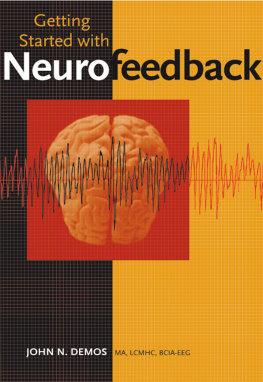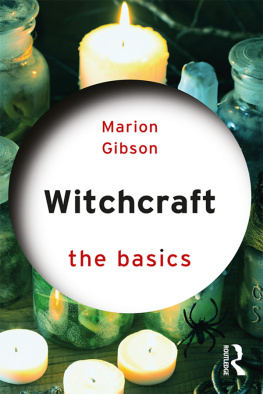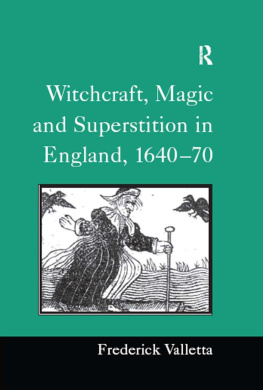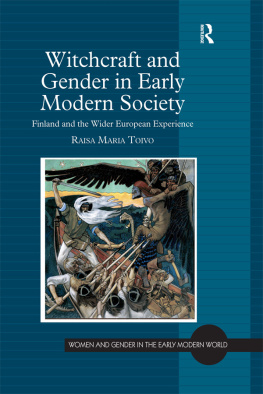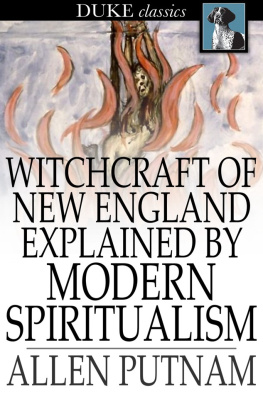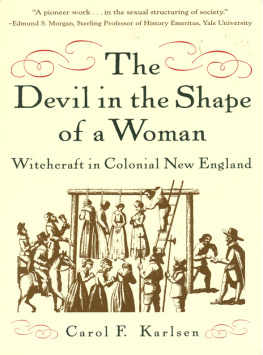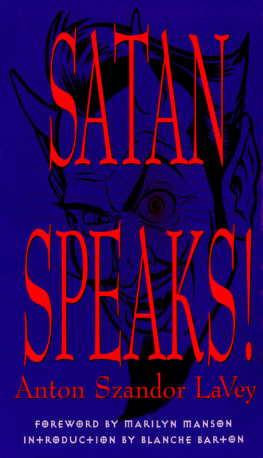Demos - Entertaining Satan: witchcraft and the culture of early New England
Here you can read online Demos - Entertaining Satan: witchcraft and the culture of early New England full text of the book (entire story) in english for free. Download pdf and epub, get meaning, cover and reviews about this ebook. City: New York;Neuengland;New England;USA, year: 2004;1982, publisher: Oxford University Press, genre: Non-fiction. Description of the work, (preface) as well as reviews are available. Best literature library LitArk.com created for fans of good reading and offers a wide selection of genres:
Romance novel
Science fiction
Adventure
Detective
Science
History
Home and family
Prose
Art
Politics
Computer
Non-fiction
Religion
Business
Children
Humor
Choose a favorite category and find really read worthwhile books. Enjoy immersion in the world of imagination, feel the emotions of the characters or learn something new for yourself, make an fascinating discovery.

- Book:Entertaining Satan: witchcraft and the culture of early New England
- Author:
- Publisher:Oxford University Press
- Genre:
- Year:2004;1982
- City:New York;Neuengland;New England;USA
- Rating:4 / 5
- Favourites:Add to favourites
- Your mark:
- 80
- 1
- 2
- 3
- 4
- 5
Entertaining Satan: witchcraft and the culture of early New England: summary, description and annotation
We offer to read an annotation, description, summary or preface (depends on what the author of the book "Entertaining Satan: witchcraft and the culture of early New England" wrote himself). If you haven't found the necessary information about the book — write in the comments, we will try to find it.
Demos: author's other books
Who wrote Entertaining Satan: witchcraft and the culture of early New England? Find out the surname, the name of the author of the book and a list of all author's works by series.
Entertaining Satan: witchcraft and the culture of early New England — read online for free the complete book (whole text) full work
Below is the text of the book, divided by pages. System saving the place of the last page read, allows you to conveniently read the book "Entertaining Satan: witchcraft and the culture of early New England" online for free, without having to search again every time where you left off. Put a bookmark, and you can go to the page where you finished reading at any time.
Font size:
Interval:
Bookmark:
Entertaining Satan
WITCHCRAFT AND THE CULTURE OF EARLY NEW ENGLAND
UPDATED EDITION
JOHN PUTNAM DEMOS


Oxford New York
Auckland Bangkok Buenos Aires Cape Town Chennai
Dar es Salaam Delhi Hong Kong Istanbul Karachi Kolkata
Kuala Lumpur Madrid Melbourne Mexico City Mumbai Nairobi
So Paulo Shanghai Taipei Tokyo Toronto
Copyright 1982, 2004 by Oxford University Press, Inc.
First published by Oxford University Press, Inc., 1982
First issued as an Oxford University Press paperback, 1983.
Updated edition issued by Oxford University Press, 2004.
198 Madison Avenue, New York, New York 10016
www.oup.com
Oxford is a registered trademark of Oxford University Press
All rights reserved. No part of this publication may be reproduced, stored in a retrieval system, or transmitted, in any form or by any means, electronic, mechanical, photocopying, recording, or otherwise, without the prior permission of Oxford University Press.
Library of Congress Cataloging-in-Publication Data
Demos, John.
Entertaining Satan : witchcraft and the culture of early New England /
John Putnam Demos.Updated ed.
p. cm.
Includes bibliographical references and indexes.
ISBN 0-19-517484-4 (cloth) ISBN 0-19-517483-6 (pbk.)
1. WitchcraftNew EnglandHistory17th century.
2. New EnglandSocial life and customs17th century.
I. Title.
BF1 576.D42 2004 974'.02dc22 2004054701
To Virginia,
Partner in all things
This book is the end of a very long inquiry. The book itself spans a good six years in the writing; the inquiry goes back two decades. My first term-paper, as a beginning graduate student in 1960, was about witchcraft, and, in a sense, I have lived with witchcraft ever since. I have loved this project, and hated it, by turns. I have frequently forsaken it for other interests, and just as frequently been reconciled. Like an old and tested companion, it has become almost a part of me.
Witchcraft is, of course, an old, old chestnut of historical interest and study; but that was not my motive in setting out. (Indeed, the popularity of the subject felt to me then, and still feels, faintly like an embarrassment.) Two factors, separate but overlapping, served to justify an effort of restudy. One was an overemphasis in previous writings on a few sensational episodeswith the Salem trials of 169293 making the single most obvious case in point. Witchcraft, I could see at the outset, belonged to the regular business of life in premodern times; or at least it belonged to the belief system, the value structure, the predominant psychology of those times. To explore its everyday presence and meaning, and thus to right the balance of research, seemed a worthy scholarly objective.
But there was a second, and deeper, objective, to which terms like system and structure directly referred. My coming of age, professionally speaking, coincided with a general growth of interest in interdisciplinary history. Efforts of intellectual bridge-buildingdemographic history, historical sociology, psychohistorymarked a new fashion in research. And such bridges seemed especially apposite to witchcraft. More than most old subjects, this one might yield new forms of understanding when re-examined in the clear light of social science. For social science was itself much taken with witchcraft. A large academic literature, especially in anthropology, canvassed materials from numerous cultures around the worldand furnished exemplary models to historians.
The range of this literature reflected an important social fact. Witchcraft is widely found, across time and space, amidst a variety of otherwise disparate circumstances; it qualifies therefore as a problem of trans-cultural significance. To study it is (or should be) more than an exercise in parochial reconstruction. Comparison, contrast, pattern, even laws of human behavior: such are the alluring possibilities that beckon scholars to witchcraft.
At least they beckoned me. And my plans for the project were fashioned accordingly. My first outlines were organized around a series of interpretive questions, lifted more or less wholesale from the social science literature. My notes from that early stage bristled with analytical models and conceptual schemas, with functions and costs, with manifest and latent tendencies. The outlines were clean and symmetrical; the notes seemed expansive enough; hence the prospects looked generally bright. But before many words had been committed to paper, I knew that something was seriously wrong. Briefly stated: my study, if continued along the same track, would be long on concepts, but distressingly short on human detail. The people were slipping through the scholarly cracks.
Back to my research files. Days of confusion. Restless nights. Conversations with friends and colleagues. (I especially remember one with a novelist of long acquaintance, which helped me to recognize how close are the imaginative worlds of history and fiction.)
I began to write stories about witchcrafttrue stories of specific episodes for which my evidence was especially full. Stories of everyday experience in all its nettlesome particulars. Stories which put individual men and women (sometimes children) right at center-stage. Stories with beginnings, and middles, and ends.
Throughout this passage I sawI feltthe historians old dilemma: history as art versus history as science. If the barricades should ever go up, I know now which way Ill jump. But better by far not to have to choose.
At any rate, this book declines to choose. Science is not renounced, only scaled down. Again and again, science has given me questionsand (less often) something like answers. (In one memorable instance scientific theory led me to search for, and then to find, important new evidence.)* My initial outlines are there in the summary chapters that conclude each major part of the study.
Yet the other chapters are truly the core. They are my stories, grown now to case studies. Their descriptive bare-bones have been fleshed out with elements of background, of context, and (at least occasionally) of overt interpretation. Fortunately, the records of witchcraft overflow with revealing detail. To go through the records is to see far more than a simple set of episodic plot-lines. Witchcraft was by definition something quite extraordinary, but it touched many other things entirely ordinary. It thus supportsit virtually demandsa style of cultural portraiture both broad and deep.
Clearly, such portraiture must evoke as well as analyze. And this is where the art comes in. For me, personally, witchcraft study has been evocative in the fullest possible sense. Indeed the word seems insufficiently strong. Through witchcraft I have come to know scores of people who lived and died centuries ago. (Sometimes I wonder, a little morbidly, how many of my contemporaries I know as well.) Rachel Clinton, John Godfrey, Elizabeth Garlick, Eunice Cole, Elizabeth Knapp and Samuel Willard, Mary Parsons and Sarah Bridgman, Elizabeth and William Morse: all have figured hugely in my thoughts and feelings, and even (once or twice) in my dreams. I think I would recognize them, and know just what to say to them, should I meet them in some otherworldly byway years hence.
An authors hubris, certainly. But I want to express my hope that this is more than a witchcraft book narrowly construed. I want readers to share my own experience of knowing the common folk and common life of a distant time.
Next pageFont size:
Interval:
Bookmark:
Similar books «Entertaining Satan: witchcraft and the culture of early New England»
Look at similar books to Entertaining Satan: witchcraft and the culture of early New England. We have selected literature similar in name and meaning in the hope of providing readers with more options to find new, interesting, not yet read works.
Discussion, reviews of the book Entertaining Satan: witchcraft and the culture of early New England and just readers' own opinions. Leave your comments, write what you think about the work, its meaning or the main characters. Specify what exactly you liked and what you didn't like, and why you think so.

